Navigating the complexities of parenting can be tough, especially when you're raising a child with unique behavioral needs. It’s a journey filled with ups and downs, but understanding and implementing effective ABA strategies can really empower you to support your child's growth and independence in everyday situations.
In this article, we’ll dive into ten essential ABA techniques that not only enhance communication and social skills but also equip you with the tools to create a supportive and structured environment. How can these strategies transform your daily interactions and lead to lasting positive changes in behavior? Let’s explore this together!
At Rori Care, we believe in a tailored approach to ABA therapy that truly meets the unique challenges each child faces. By empowering your little ones with essential skills, we help them navigate the world with confidence and independence. Our qualified analysts conduct thorough evaluations to create personalized intervention plans that tackle specific issues, ensuring that therapy incorporates ABA strategies for everyday situations and remains effective. This customized approach not only boosts the effectiveness of interventions but also helps parents implement strategies that align with their child’s individual needs.
Research shows that kids who engage in early, intensive ABA therapy - typically around 25 hours a week - often see remarkable improvements in communication, social skills, and adaptive behaviors. At Rori Care, we emphasize the importance of caregiver education. We equip families with ABA strategies for everyday situations, enabling them to actively support their child’s behavioral goals through involvement and data collection. This education not only enhances support but also leads to informed decision-making and better behavioral outcomes.
What’s more, our innovative approach combines personalized therapy with cutting-edge AI technology, allowing us to generate progress reports automatically. This means we can free up 50% more time for your child’s treatment, making ABA therapy even more efficient. By focusing on the unique traits of each child, Rori Care ensures that every young person receives the best possible support, paving the way for significant growth and progress. With ABA therapy showing a success rate of over 89%, we’re excited to be part of your journey!
Let’s explore this together and see how we can help your child thrive!
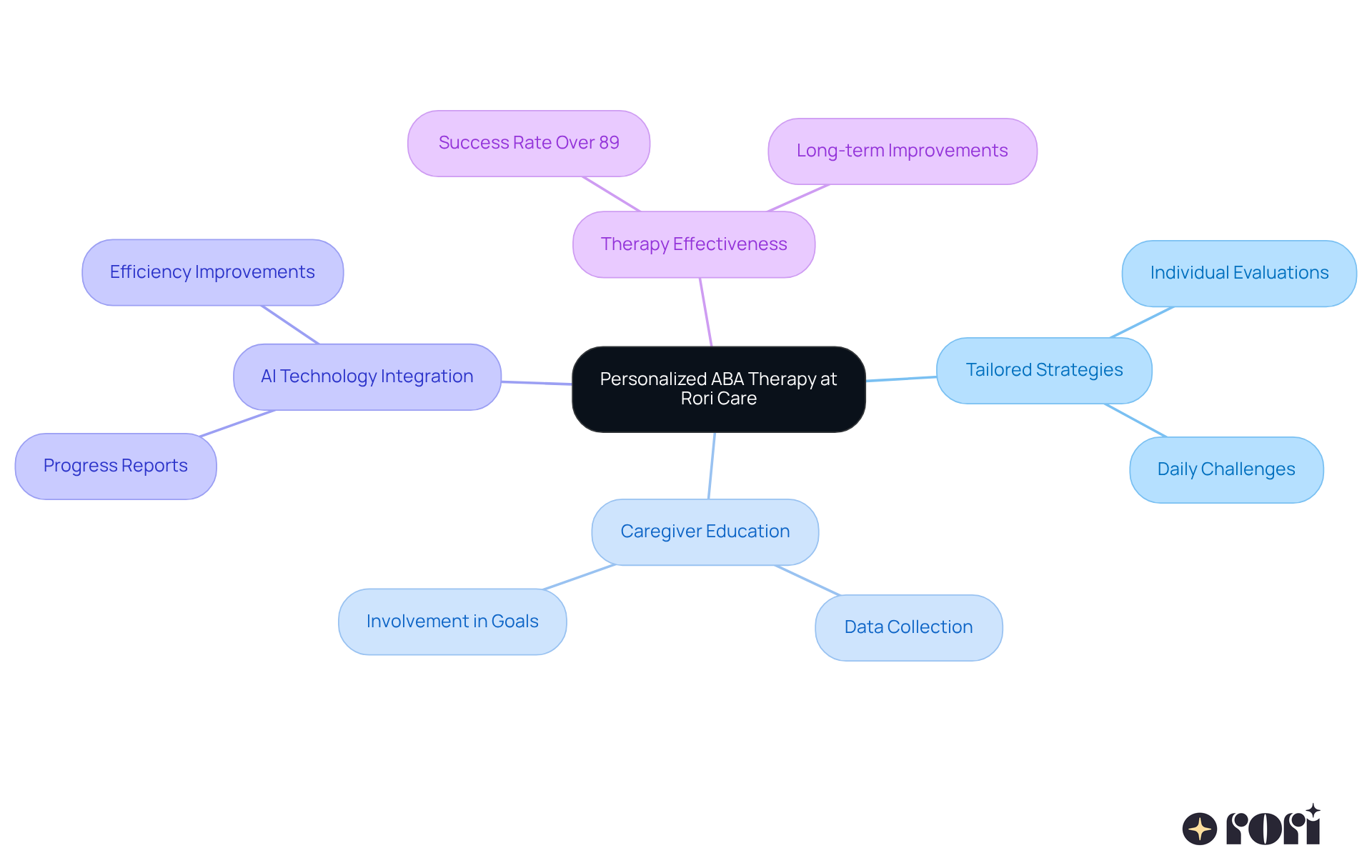
Positive reinforcement is such a powerful approach! It’s all about rewarding those desired actions to encourage them to happen again. Parents can really make this work by giving prompt praise, small rewards, or even privileges when their little ones show positive behaviors. For instance, if a child shares their toys with a sibling, recognizing that with a simple "Great job!" or a sticker can really motivate them to keep sharing. Studies even show that a feedback ratio of five positive reinforcements to one negative can boost a young person’s engagement and motivation, leading to lasting change.
But it’s not just about reinforcing good behavior; it also strengthens the bond between parents and kids. When parents create a supportive atmosphere where children feel acknowledged and appreciated, it helps cultivate a sense of belonging and self-worth. Plus, research indicates that kids who experience positive interactions tend to have better attention spans, memory retention, and problem-solving skills.
We’ve seen successful applications of ABA strategies for everyday situations, particularly through positive reinforcement, showcasing its effectiveness in various settings. For example, structured routines developed through ABA methods can help kids manage unstructured time, reducing anxiety and promoting positive interactions. By focusing on rewarding specific behaviors, parents can utilize ABA strategies for everyday situations to guide their children toward developing essential social skills and emotional regulation, ultimately enhancing their overall well-being. And remember, specific and personalized praise is way more effective than general compliments; it helps kids recognize their strengths and areas for improvement.
Additionally, equipping caregivers with education on ABA strategies for everyday situations can really boost their ability to support their children’s development. With a better grasp of personalized planning, measurable goals, and ongoing assessment, caregivers can make informed choices that positively impact their child’s progress. This active involvement, combined with therapeutic strategies, often leads to improved behavioral outcomes and greater confidence in their caregiving role.
Let’s explore this together! By embracing positive reinforcement, we can create a nurturing environment that benefits both parents and children.

Visual aids, like charts, images, and schedules, are super helpful for young learners when it comes to understanding their daily routines and what’s expected of them. For example, a visual timetable that lays out the steps for getting ready for school can really help kids know what’s coming next. This not only eases their anxiety but also encourages them to stick to the routine. Research shows that visual schedules, which are effective aba strategies for everyday situations, can boost on-task behaviors and help kids with autism follow routines better, especially when these aids are paired with prompting and reinforcement strategies.
Creating effective visual aids at home is a breeze for parents! You can use simple images or drawings to represent daily activities. These handy tools not only help kids navigate their routines more smoothly but also give them a sense of control and predictability. Educators often highlight how important it is to customize visual supports to fit each child’s needs, as this can really enhance their engagement and cooperation.
With technology evolving, we’re seeing some exciting new visual aids, like video-enhanced schedules, that are making a difference in routine compliance. These advancements show just how committed we are to finding ways to help individuals with autism manage their daily lives more effectively. By using aba strategies for everyday situations, parents can weave visual aids into their routines to create a more organized and nurturing environment that encourages independence and reduces behavioral challenges.
Let’s explore this together! If you’re looking for ways to support your child, remember that you’re not alone in this journey. We’re here to help you every step of the way!

Prompting techniques are so important in Applied Behavior Analysis (ABA) because they provide organized cues or support to help our little ones learn new skills or show desired behaviors. For example, when teaching a child to tie their shoes, a parent might start with a gentle physical prompt, guiding their hands through the motions. As the child becomes more skilled, this assistance can be gradually faded, encouraging them to do it on their own. Verbal prompts, like reminding them to 'cross the laces,' can also be super effective in reinforcing what they’ve learned.
Research shows that systematic prompting procedures can lead to a 73% improvement rate in skill acquisition. Isn’t that amazing? This really highlights how effective these methods can be! Caregiver education, including ABA strategies for everyday situations, is key here, too. It helps parents understand ABA principles and strategies, empowering them to make informed choices that positively impact their child’s progress.
BCBAs emphasize that the secret to successful prompting is tailoring the approach to each child’s unique needs. This way, prompts can be gradually reduced, fostering independence. Some successful prompting strategies include:
These strategies have been shown to be beneficial in teaching social skills and daily living tasks.
By thoughtfully implementing these ABA strategies for everyday situations, caregivers can significantly boost their child’s ability to navigate with confidence and independence. This ultimately leads to better behavioral outcomes and empowered parents. Let’s explore this together!
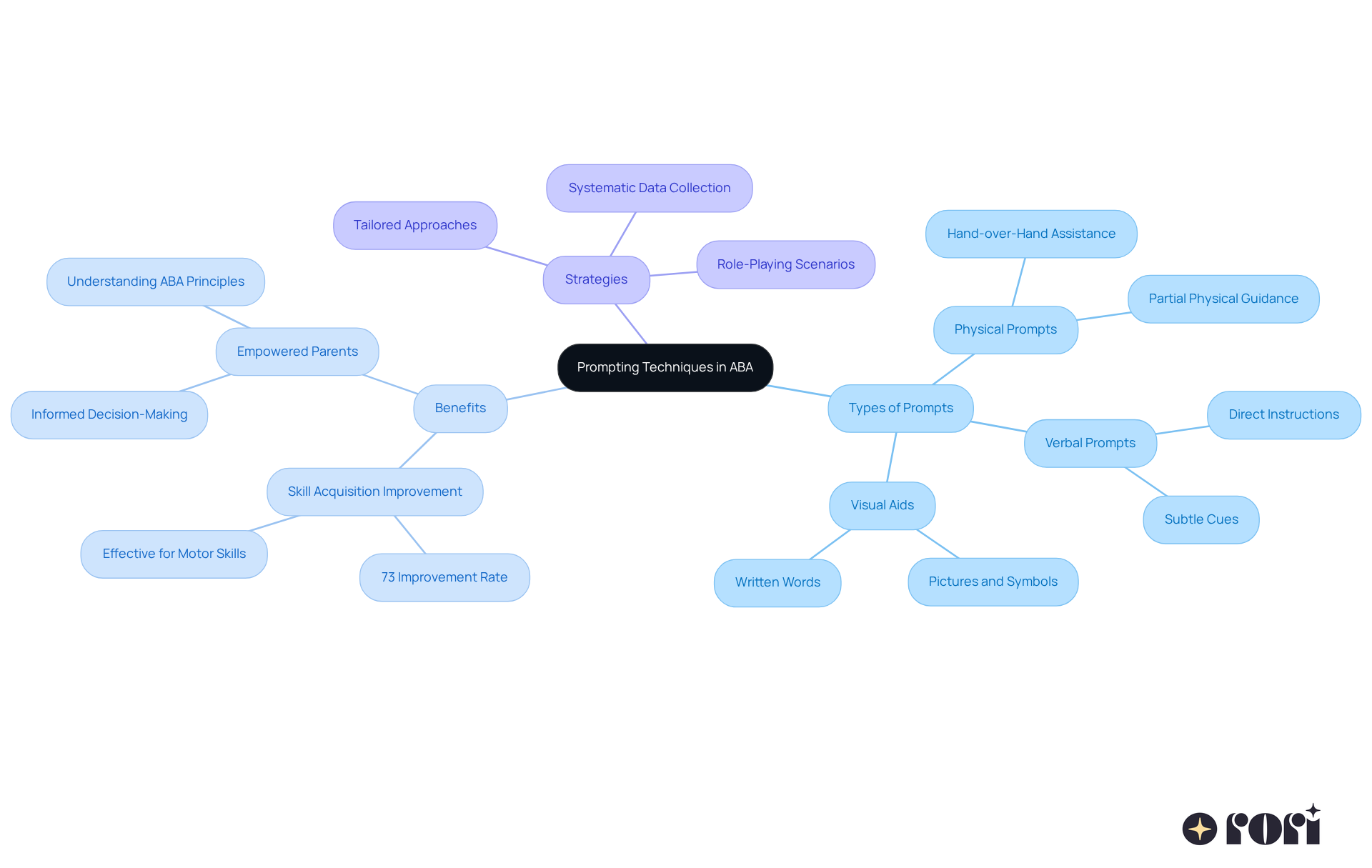
Behavior contracts are like friendly agreements between parents and their kids, laying out clear expectations and the consequences for meeting or missing those goals. For example, a contract might say that if your child does their homework every day for a week, they’ll earn some extra screen time on the weekend. This not only makes it clear what’s expected but also helps kids take responsibility for their actions, reinforcing good behavior with structured rewards.
Research shows that ABA strategies for everyday situations can really help kids stick to their commitments and reduce challenging behaviors, especially for those with autism. By encouraging responsibility and excitement, behavior contracts create a supportive environment that motivates kids to engage in positive actions. The key to success? Working together! When kids help set their own goals and choose their rewards, they’re more likely to stay committed to the agreement.
Recent studies highlight that behavior contracts, as ABA strategies for everyday situations, are flexible and can be tailored to meet each child’s unique needs, making them effective tools at home and in therapy. When used consistently, they lead to noticeable improvements in behavior, helping kids understand how their actions connect to the outcomes they experience. This organized approach not only benefits the child but also enhances communication and collaboration between parents and teachers, paving the way for a more positive developmental journey.
Let’s explore this together! If you’re curious about how to implement behavior contracts in your home, we’re here to help you every step of the way!

Naturalistic teaching is all about using everyday moments as fantastic learning opportunities for our little ones. Think about mealtime - parents can really boost communication by encouraging kids to ask for things or share their likes and dislikes. This approach not only makes learning relevant but also helps children practice their skills in real-life situations through ABA strategies for everyday situations.
Research shows that kids who experience naturalistic teaching strategies often see big improvements in their communication, social skills, and adaptive behavior. In fact, many start making progress within just a few weeks of beginning these interventions! By incorporating ABA strategies for everyday situations into daily routines, parents can create a rich environment for skill development without needing formal teaching sessions.
Educators highlight that this learner-focused, play-oriented method maximizes those precious learning moments and fosters meaningful growth. It’s all about enhancing our children’s overall development in a way that feels natural and fun. So, let’s explore this together and see how we can make the most of those everyday activities!
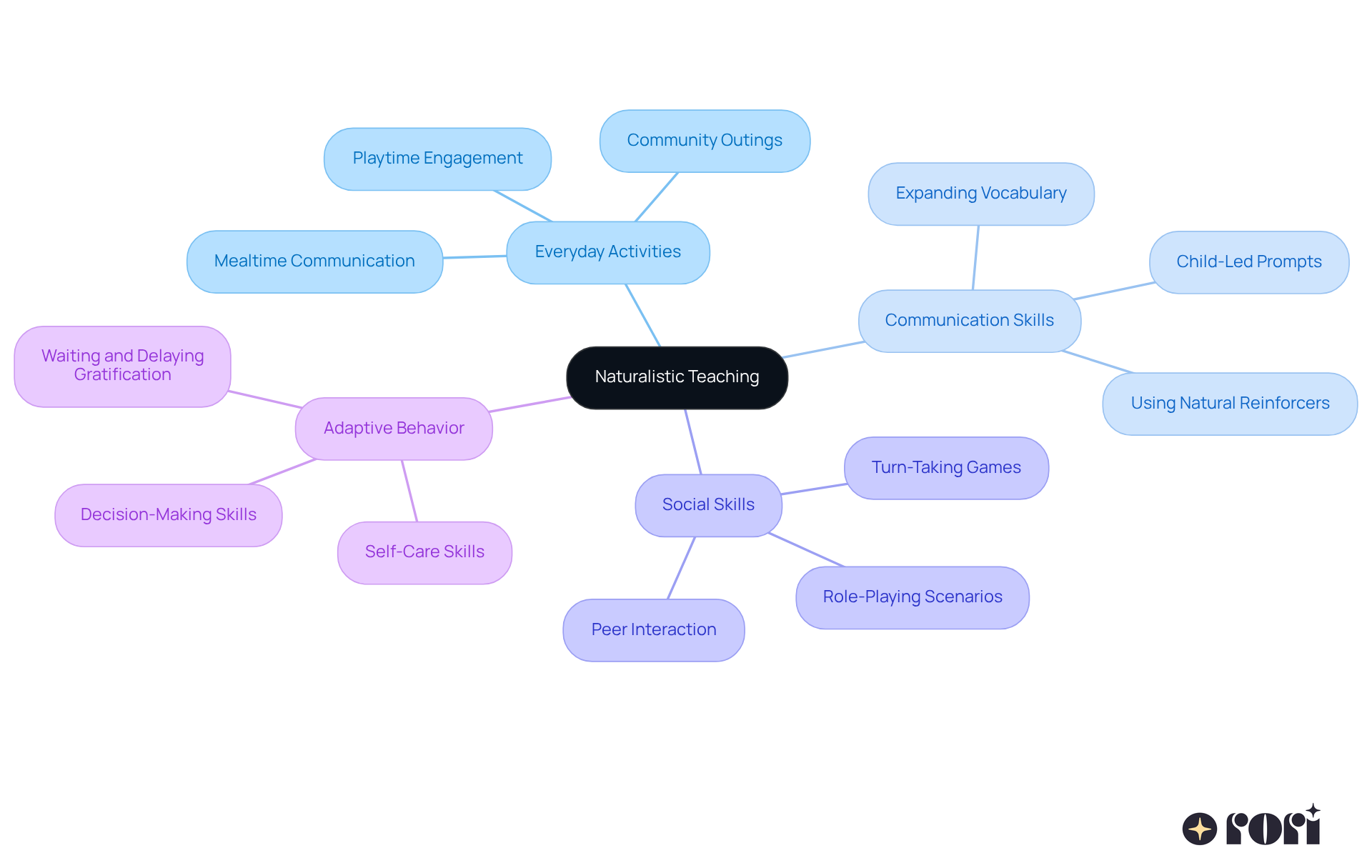
Self-monitoring is a fantastic way for young people to keep an eye on their own actions. Parents can make this process easier by using checklists or charts, helping kids track their progress on specific tasks or behaviors. For example, a child might use a chart to check off every time they remember to say 'please' and 'thank you.' This not only encourages independence but also motivates them to think about their actions and make any needed changes.
Research shows that self-monitoring can lead to big improvements in task completion and a drop in disruptive behaviors. In fact, studies indicate that kids who practice self-monitoring often show a noticeable boost in their ability to manage their behavior effectively. By equipping caregivers with ABA strategies for everyday situations, parents can enhance their involvement in this process, ensuring they provide consistent support at home.
This active participation not only promotes independence through self-monitoring but also aligns with the benefits of caregiver education, like informed decision-making and better behavioral outcomes. Ultimately, this all contributes to the overall development of their children. Let’s explore this together and see how we can support our kids in becoming their best selves!
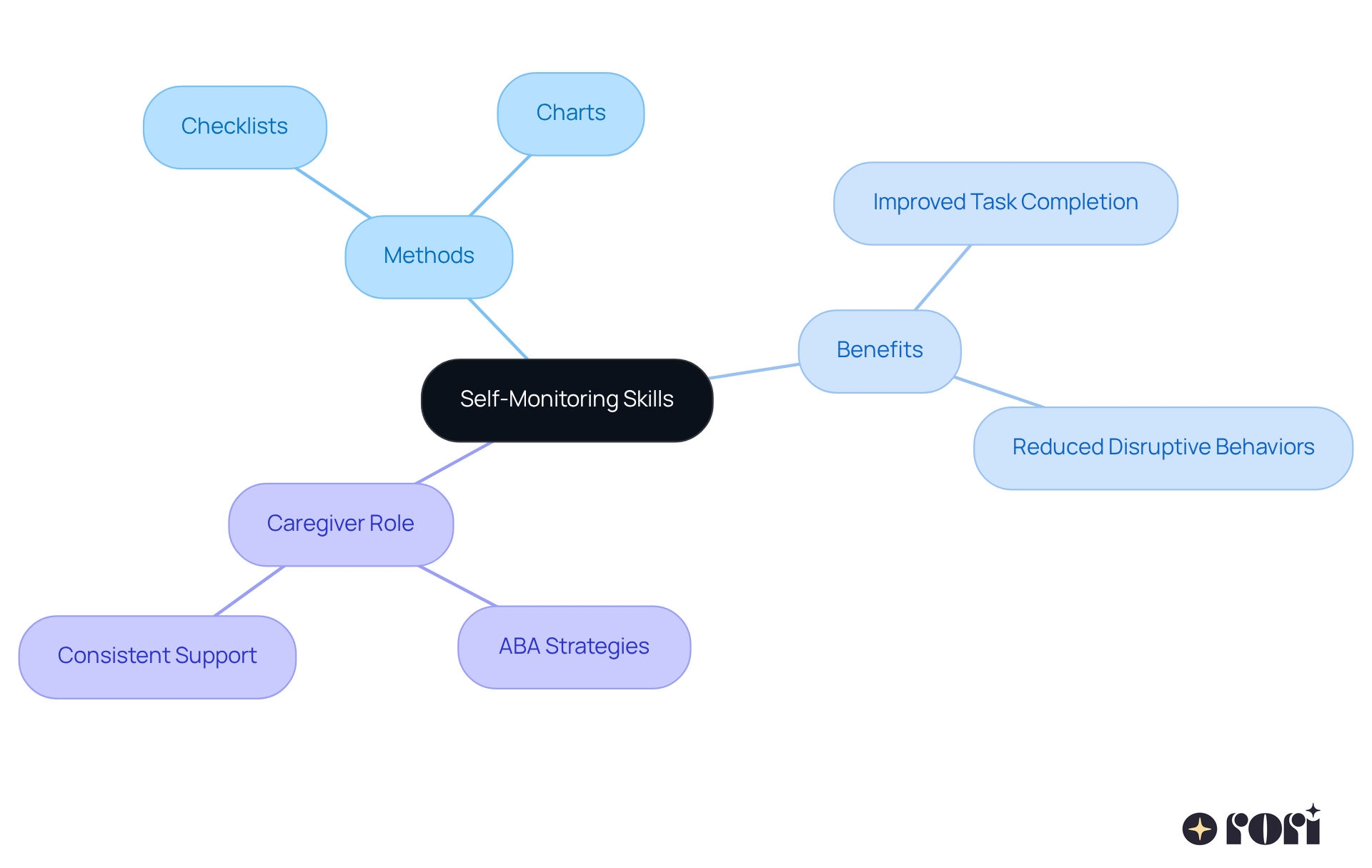
Task analysis is a fantastic way to simplify tasks by breaking them down into smaller, manageable steps. For example, when teaching a little one to brush their teeth, parents can outline each action:
This step-by-step approach helps young learners focus on one task at a time, nurturing a sense of accomplishment and boosting their confidence.
Research shows that skills taught through task analysis are 45% more likely to generalize to new situations. This makes it especially effective for complex tasks that might overwhelm young learners if presented all at once. Plus, structured task analysis can improve skill acquisition rates by 60-75% compared to traditional teaching methods. By tailoring task analysis to each child's current skill level and learning history, parents can create a supportive environment that enhances understanding and retention.
BCBAs emphasize that effective task analysis requires thoughtful planning and consistent data collection to track progress. This aligns perfectly with the principles of Applied Behavior Analysis (ABA), where caregiver involvement is key. Studies show that consistent data collection can improve learning outcomes by up to 40% compared to instruction without regular monitoring. When caregivers understand ABA principles, they’re better equipped to support their child’s learning at home, leading to improved behavioral outcomes and greater independence.
As one expert put it, "Utilizing task analyses can be the key to helping a young individual become more independent." This organized method not only aids in skill development but also encourages long-term mastery, ensuring that young individuals can effectively use ABA strategies for everyday situations with greater ease. Let’s explore this together and see how task analysis can make a difference in your child’s learning journey!

Consistency is key in ABA therapy! It helps kids generalize their skills in different places. As parents, it’s important to maintain consistent expectations and responses by utilizing ABA strategies for everyday situations at home, school, or out in the community. For example, if your little one gets a high-five for helping with chores at home, they should receive the same praise when they lend a hand at a relative's house. This kind of consistency not only boosts learning but also applies ABA strategies for everyday situations, building trust and security, which makes kids more open to new learning experiences.
By joining caregiver education programs, you can really deepen your understanding of ABA strategies for everyday situations and their principles. This knowledge empowers you to make informed choices that can positively influence your child's progress. Plus, being actively involved helps you provide the right support at home, which complements professional interventions and keeps things consistent across different settings.
And let’s not forget, caregiver education can lead to better behavioral outcomes! It also empowers you as caregivers, reducing stress and improving family dynamics. So, let’s explore this together! We’re here to help you every step of the way!

Working together with experts, like Board-Certified Behavior Analysts (BCBAs) and therapists, is so important for guardians looking to apply effective ABA strategies. These professionals provide personalized guidance, training, and ongoing support, helping parents feel confident in using techniques at home. When there's consistent communication with these experts, adjustments can be made quickly based on the child's progress, ensuring that strategies remain effective and tailored to their unique needs. Parents are encouraged to explore resources and support networks that deepen their understanding of ABA techniques, creating a collaborative environment that truly benefits their child's development.
Recent developments in professional support have focused on boosting caregiver involvement in the therapy process. Successful examples of caregiver-professional partnerships show that when guardians actively collaborate with BCBAs and therapists, the outcomes for children improve significantly. For instance, when parents participate in training sessions and share insights about their child's behavior, they can help experts refine intervention strategies, leading to more effective therapy.
BCBAs highlight the importance of this teamwork, noting that "the individualized attention provided by a BCBA is crucial for maximizing the success rates of ABA therapy." By working together, parents and professionals can create a supportive framework that not only addresses behavioral challenges but also nurtures overall development and independence.
To enhance your involvement even further, consider attending caregiver education workshops offered by Rori Care - ABA Therapy. These workshops offer valuable insights into ABA principles, empowering you to make informed decisions and actively support your child's behavioral goals. Let’s explore this together!
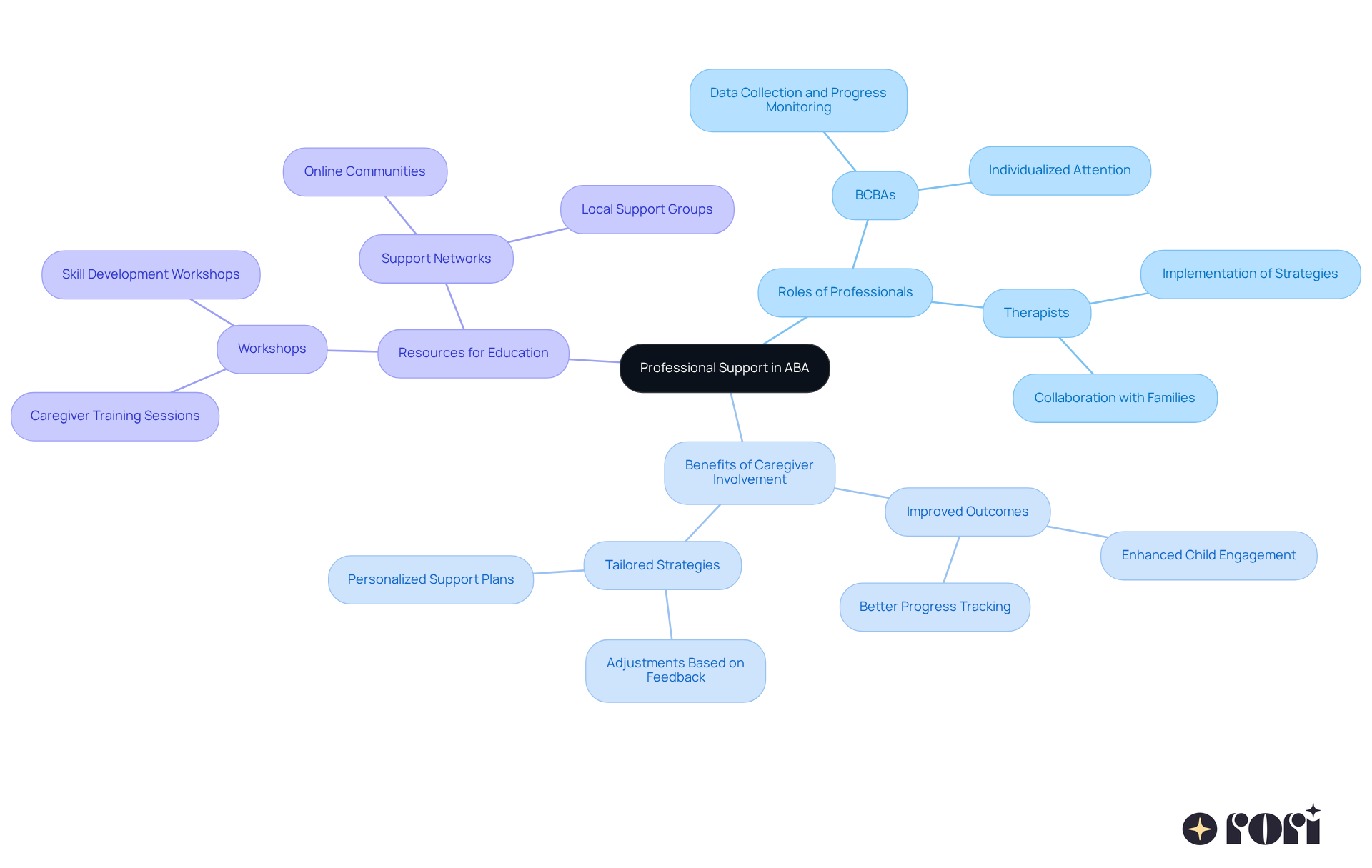
Every parent wants to give their child the best support possible, and understanding ABA strategies for everyday situations is a fantastic way to do just that! By weaving these techniques into daily life, parents can help their kids become more independent, improve their communication skills, and create a warm environment that encourages positive behaviors. The key takeaway here is that personalized approaches, like those offered by Rori Care, can truly empower children, helping them navigate their world with confidence.
Throughout this article, we’ve explored some effective ABA strategies, such as:
Each of these methods offers practical tools that parents can easily incorporate into their daily routines, ensuring that children get the tailored support they need. By actively engaging in their child's development and teaming up with professionals, parents can make informed decisions that lead to meaningful progress.
Ultimately, embracing these strategies not only benefits children but also strengthens the bond between parent and child, creating a more harmonious family dynamic. As caregivers continue to learn and apply these techniques, they’re paving the way for their children to thrive in various aspects of life. The journey might be challenging, but with the right support and resources, every child can reach their full potential. Let’s explore this together!
What is Rori Care's approach to ABA therapy?
Rori Care believes in a tailored approach to ABA therapy that meets the unique challenges each child faces, empowering them with essential skills to navigate the world confidently and independently.
How does Rori Care create personalized intervention plans?
Qualified analysts at Rori Care conduct thorough evaluations to create personalized intervention plans that address specific issues, ensuring the therapy incorporates ABA strategies for everyday situations.
What are the benefits of early, intensive ABA therapy?
Research indicates that children who engage in early, intensive ABA therapy, typically around 25 hours a week, often experience significant improvements in communication, social skills, and adaptive behaviors.
How does Rori Care support caregiver education?
Rori Care emphasizes caregiver education by equipping families with ABA strategies for everyday situations, allowing them to actively support their child's behavioral goals through involvement and data collection.
What innovative technology does Rori Care use in their therapy?
Rori Care combines personalized therapy with cutting-edge AI technology to automatically generate progress reports, freeing up 50% more time for children's treatment and making ABA therapy more efficient.
What is the success rate of ABA therapy at Rori Care?
ABA therapy at Rori Care has a success rate of over 89%, indicating its effectiveness in helping children thrive.
What is positive reinforcement in the context of ABA therapy?
Positive reinforcement involves rewarding desired actions to encourage their recurrence, such as giving praise or small rewards when children exhibit positive behaviors.
How can parents effectively use positive reinforcement?
Parents can effectively use positive reinforcement by providing prompt praise or rewards when their children display positive behaviors, creating a supportive atmosphere that enhances the parent-child bond.
What are the benefits of using visual supports for children?
Visual supports, like charts and schedules, help children understand daily routines, reduce anxiety, and improve compliance with expectations, particularly for children with autism.
How can parents create effective visual aids at home?
Parents can create visual aids using simple images or drawings to represent daily activities, which helps children navigate their routines and provides a sense of control and predictability.
What advancements are being made in visual aids for children?
New visual aids, such as video-enhanced schedules, are emerging, showing a commitment to helping individuals with autism manage their daily lives more effectively.
How can parents incorporate visual aids into their routines?
Parents can integrate visual aids into their routines to create a more organized and nurturing environment, encouraging independence and reducing behavioral challenges.